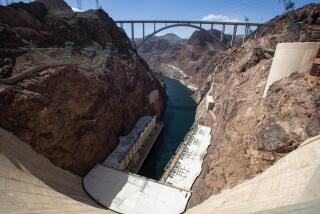Water Users Face Doubled Bills or Worse if 20% Reduction Isn’t Met : Drought: Cutbacks take effect June 17 for 200,000 people, 60% of them in the Antelope Valley.
- Share via
Residents and businesses in much of the Antelope Valley will have to cut their water use by an average of 20% starting next week under a new conservation program or face penalties that could at least double their water bills.
The required cutbacks, approved last month by Los Angeles County supervisors, are set to take effect June 17 for an estimated 200,000 people served by 16 county waterworks districts. County officials said about 60% of those people are in the Antelope Valley.
To promote conservation, county officials said they structured the program to about double the water bills of typical customers who make no reduction. Those using 10% more water could pay nearly triple. “Most people will not be willing to pay that,” said Gary Hartley, a county waterworks official.
The mandatory program, similar to those already adopted in the city of Los Angeles and elsewhere, is necessary because the state is in its fifth year of drought and municipal water deliveries from the crucial State Water Project have been cut by 80%, county officials said.
The county program is relatively straightforward for larger water customers such as businesses and commercial centers. They must reduce their water use in each two-month billing period by 20% from their own actual use during the same two months between April, 1989, and March, 1990.
The rules are similar for homeowners, with one major exception. Their mandated 20% cutback is not based on their own water use for that prior period. Instead, they must use 20% less than the prior average for all customers in their district with the same size water meter.
For example, a Lancaster household with a standard 3/4-inch water meter would get a water allotment of 549 gallons per day in June and 652 gallons per day in July, 20% below the prior averages. Penalties would only apply to excess water use for a billing period, not for individual days.
A Lancaster customer who failed to make any of the 20% reduction in those months would pay $81.20 for that larger amount of water, nearly double their $42.20 bill prior to the penalties, county officials said. In contrast, the customer who made the 20% cut would pay only $35.70.
Under the county’s penalty system, customers would be surcharged an extra $3 for every billing unit of water they use between their goal of a 20% cut and their 1989-1990 average. Water usage above the average amount would carry a surcharge of $6 per billing unit. A billing unit is 748 gallons of water.
Hartley said the county chose the averaging method to avoid penalizing families that have been conserving. They probably would already be meeting the 20%-reduction goal. Also, he said it will thwart those who have been using a lot of water in hope of gaining a larger allotment.
However, Hartley acknowledged that the county approach has a drawback because it sets the same water use targets for all households within a district with the same size water meters. The method makes no distinction between a house where a couple reside or one with 10 occupants. Their water allotments would be the same.
The water use targets for households are broadly based on four-person occupancy, Hartley said. However, he added that the county will grant water allotment increases to households with more occupants if they file a simple written appeal with the county within 20 days of getting any penalty. When the appeal is granted, the penalty will be waived.
Water allotments will vary among the county’s 16 water districts, because the amounts are based on customers’ actual water use for the 1989-1990 period. Allotments for the Antelope Valley are as much as double those of some other county areas because historically water use is greater in the high desert.
Although the county’s program has not formally started, Hartley said the districts have already received letters from more than 60 customers requesting increases in their water allotments. Hartley said those customers have been told they must wait until getting a bill with a surcharge.
Unlike the city of Los Angeles’ 15% mandatory conservation program and ones in other communities, the county will not allow customers credit for water they save beyond requirements or let them make up excess use in later months. Hartley said that would be too complicated for the county’s billing system.
Although the city’s 15% cutback has been in effect since May 1, customers who have not been meeting that goal will not get their first bill penalties until July because of the two-month billing cycle. Similarly, the county’s first bills with penalties would not arrive until about September.
Despite its lesser 15% target, the city’s program can have tougher penalties. For third and subsequent violations, the city will add a 75% bill surcharge and then add a $4 per excess billing unit penalty. Repeat violators in Los Angeles also can have their water shut off for up to 48 hours.
The county last week completed a mailing to all of its customers with a letter explaining the new conservation program and giving them a card that shows their individual or average month-by-month water use for the 1989-90 period, and the reduced use levels they must now meet.
The Board of Supervisors approved the program May 23. County officials had intended the penalties for excess use to begin accruing today, as stated in the customer letters. But Hartley last week said that has been delayed to next Monday to ensure that everyone has been notified.
Nine of the 16 county waterworks districts are in the Antelope Valley area, including District 4, the largest, with about 23,200 water meters (or, officially, customers) in and around Lancaster. A smaller operation, District 34, has about 2,800 meters in west Palmdale.
The other Antelope Valley-area districts are Pearblossom, Littlerock, Sun Village, Northeast Los Angeles County, Acton, Lake Los Angeles and Rock Creek. The other districts serve Val Verde, Malibu, Athens-Woodcrest, Willowbrook, Miramonte Park, Kagel Canyon and Liberty Acres.
The required 20% cutback is part of a conservation program adopted by the supervisors. It increases in 5% steps to a maximum 50% water use reduction. However, Hartley said the county probably will stay at 20% at least through the summer.
He said residents should look to reduce their landscape watering as the easiest way to make the 20% reduction, adding that exterior watering can account for up to 60% of a family’s water use. The county also plans to send its customers information on how they can read their own water meters.
Water Conservation Goals
Chart shows goals under Los Angeles County’s 20% cutback program for typical homes (those with 3/4-inch water meters) in Lancaster-based District 4, the largest water district in the Antelope Valley area:
If homeowners cut their water use by 20%, they pay normal rates. Homeowners who reduce their water use by less than 20% will pay a $3 surcharge for every 748 gallons used over the 20% reduction level.
But if homeowners use above the base figure (a 1989-90 districtwide average), they will pay the $3 surcharge per 748 gallons used between the 20% cutback target and the base figure, and then an additional $6 per 748 gallons for everything over the base figure.
The 748-gallon figure is what the county calls a billing unit.
Gal. per day Jan. Feb. March April May June 89-90 Avg. 410 401 314 424 531 698 20% Cut Goal 337 321 241 349 434 549 Billing Units 89-90 Avg. 17 15 13 17 22 28 20% Cut Goal 14 12 10 14 18 22
Gal. per day July Aug. Sept. Oct. Nov. Dec. 89-90 Avg. 820 893 1022 869 773 579 20% Cut Goal 652 724 823 700 623 459 Billing Units 89-90 Avg. 34 37 41 36 31 24 20% Cut Goal 27 30 33 29 25 19
Average two-month bill
Using the average amounts listed above for the months of June and July. 62 units was the average for June-July. 49 units is the conservation goal.
$42.20: 62 units prior to the water conservation program
$81.20: 62 units after the water conservation program (no cutback, with surcharge)
$35.70: 49 units (a 20% cutback) after water conservation
More to Read
Sign up for Essential California
The most important California stories and recommendations in your inbox every morning.
You may occasionally receive promotional content from the Los Angeles Times.










